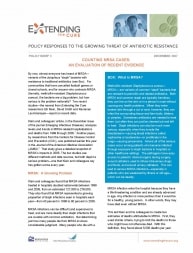June 14, 2010

By now, almost everyone has heard of MRSA— variants of the ubiquitous “staph” bacteria with resistance to traditional antibiotics (see Box). For communities that have cancelled football games or closed schools, and for anyone who contracts MRSA (formally, methicillin-resistant Staphylococcus aureus), the bacteria are a big problem, but how serious is the problem nationally? Two recent studies—the newest from Extending the Cure researchers Eili Klein, David Smith and Ramanan Laxminarayan—report on recent data. Klein and colleagues’ article, in the December issue of the journal Emerging Infectious Diseases, analyzes levels and trends in MRSA-related hospitalizations and deaths from 1999 through 2005. Another paper, by researchers from the Centers for Disease Control and Prevention (CDC), was published earlier this year in the Journal of the American Medical Association (JAMA). That study gives a detailed snapshot of MRSA’s impacts in 2005. The two studies use different methods and data sources, but both depict a serious problem—one that Klein and colleagues say has gotten worse every year.

